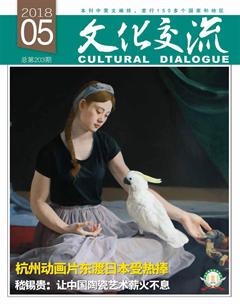水印文化:傳承千年的東方智慧
張侃誠
“水印千年——中國水印版畫大展”日前在浙江美術館展出。
中國是版畫藝術的發祥地,早在漢代就出現了用版畫漏印法在織物上制作的工藝布版畫,此后從用墨汁和水質顏料印刷的古代水印木刻到汲取了傳統版畫、民族繪畫、民間美術精華的現代水印創作,無不鮮明地體現出中華民族意境自然的藝術特色與東方文化含蓄雋永的美學品格。
水印版畫作為發端于中國的一門獨特技藝,從隋代木刻刊刻至今的1400多年的歷史演變始終承載著東方社會獨有的內生視野和記憶感覺,深刻蘊含著中國的東方美學精神。
直觀呈現東方文化“水”性內涵
杭州與水印藝術的淵源已逾越千年,得天獨厚的自然環境和深遠的人文內蘊與之血脈相契。“水印千年——中國水印版畫大展”,通過“版刻千秋——中國傳統水印版畫”“汲古鐫今——中國現當代水印版畫”“東方意蘊——中國木版年畫與浮世繪”“湖山勝概——西湖主題水印版畫”“拓山印湖——公共藝術項目”五個篇章觀照“水印版畫”這一古老卻又新意十足的藝術。展覽力圖整合日常與經典、廟堂與自然、詩意與謹嚴、真實與奇幻、私人與公眾、體驗與程式、傳統與現代、原始與未來等豐富維度構建起當代水印時空,以圖像、文字、實物、影音、公共活動等多種創作樣式,探索邊界、發掘水印文化的美學生命力,直觀呈現東方文化“水”性內涵的魅力。
“水印千年”大展也是浙江美術館“東方智慧”系列展覽的開端。系列展以“東方智慧”為元點,以5年左右時間展開一場“向西歸東”的精神之旅,即通過2016—2018年的“水印千年”、2019年的“紙上談繽”、2020年的“山海經”,在“東方視野”之中,整體呈現“形態敘事——認知拓展——精神溯源”的主旨延展,來探索、復興和呈現深蘊其中的中華民族智慧歷久彌新的活力。
從“版刻千秋”到“拓山印湖”
大展第一板塊“版刻千秋”以代表性的古典版畫圖像、大型雕版實物裝置作品以及古籍文獻呈示水印藝術的演進歷程,為整個大展提供一個悠遠的時間背景。
展品包括漢傳、藏傳以及西夏時期的不同經卷,意在反映傳播的廣遠性。各類古籍插圖中最具中國傳統人文內涵和審美成就最高的部分還屬明清時期小說、傳奇,這些精美而富含情節意味的插圖既是傳統智慧和民間技藝的結晶,在世俗生活的流播過程中又對建構我們民族的審美意趣和價值導向產生了深刻久遠的影響。此外,還特別選取陳洪綬《西廂記·窺簡》一圖為藍本,以動漫、影像手段進行活化再造,挖掘歷史圖像的表現潛力,探尋古今圖像傳播和接受方式的內在關聯。隨著傳統水印技藝的不斷精進,“書畫仿制”體系也應運而生,從歷代各類書畫譜發展到后世以書畫仿制見長的“榮寶齋”“朵云軒”專營機構,再到以技藝傳承和藝術創作實踐為主旨的“紫竹齋”(中國美術學院)等院校工作室,構成了與當代水印的審美和技藝發展歷程最為切近的發展脈絡,此類作品也一并納入其中。
“汲古鐫今”板塊以各地區水印名家的代表性作品展現1950年至2000年間中國現代水印版圖概貌,并借此梳理中華人民共和國成立后,現代水印技藝的生成、遷播、流變的歷史。其中,特別推出數位中生代藝術家專題,通過他們各自有代表性思維和創作方式,呈現水印藝術歷久彌新、柔韌而強大的內在精神。
“東方意蘊”板塊,展示中日兩國具有代表性、元素相互影響的轉換階段作品,借此喚起人們對東方古國共通的文化精神及其生命力的認識。
在中國民間傳統年畫部分,除能見到楊柳青、桃花塢、漳州等各個地區典型作品外,還有一部分“半印半繪”樣式的展品,如山東撲灰年畫等。與人們熟知的節慶畫那種熱烈吉祥的審美追求有所不同的是,這部分展品在形制、題材等方面鮮明體現人倫教化功能或是文人繪畫意趣,呈現出民俗民間與書畫元素的融合狀態,反映了傳統水印技藝在歷史發展中具有的豐富可能性和強大的實踐力。中日兩國一衣帶水,有著悠久的文化交流歷史,典型的日本浮世繪即是在接受中國水印版畫技藝的影響的基礎上形成了獨特的發展面貌。同時,作為一種市井風情型的繪畫樣式,日本浮世繪與我國民間年畫等民俗版畫在傳播效應和呈現樣態上有相當的可比性。
2016年8月,浙江美術館成功策劃并實施了“湖山勝概——‘水印千年啟動展”。在展陳語言和內容方面都進行了一些突破性的嘗試,將新穎的陳設手段融景觀、歷史、文化與傳統技藝于一體,不僅觀照于古今西湖的歷史變遷,更形象化地凝練了西湖的詩意特質。

“湖山”為歷代文人對杭州城市空間詩意精神的形象概括。“拓山印湖”用中國傳統碑拓技藝中的標志性手段——“印”與“拓”,擇取歷史人文遺跡豐富的吳山和西湖水域的經典景觀構成“湖山”現場。藝術家以大地為版、自然為版、時間為版,以各種人文印跡與自然造物為素材,拓歷史、拓萬物,拓眾生、拓天下。從形態而言,它與畫作形成了相宜的動靜關系;從觀念而言,與啟動展“湖山勝概”形成呼應,“見山還是山”。
“拓山印湖”的靜態成果是展覽的重要組成部分,而媒體介入和現場互動的過程也成為一個公共文化事件。通過公眾在地體驗的方式,喚起參與者對中國美學血脈、文化精神的再認識。觀眾可以通過展覽體驗到水印文化所內蘊的“東方智慧”,它既可以具體到一個技巧動作,一個精微的局部、一幅畫面,又可以是浩大的,直接關涉一個文化領域、一方天地。
水印大展的走出去和引進來
“湖山勝概”被文化部評為2016年全國美術館8個優秀展覽項目之一,先后得到了日本、德國及我國香港特區等地藝術機構的認可和邀約。通過2016年到2017年期間“湖山勝概”展的推進實踐,對當代文化建構語境下傳統敘事的思考也日漸清晰。事實證明,地域和歷史問題并非當代中國展覽走向世界的關鍵阻滯,展覽的國際性和當代性需要更恰當的策展思維來實現。“拓山印湖”的在地項目還將隨著展覽持續流動至各地,如“一帶一路”沿線國家等,在世界各地陸續實施。
同時,本次展覽引入日本浮世繪作品,諸如有“浮世繪三杰”之稱的葛飾北齋、安藤廣重和喜多川歌麻呂等當世頂尖畫師們。通過一系列的藝術鑒賞與交流,研究對比中國傳統技藝的變遷與發展,從而認同民族文化,不斷豐富民族文化,發展先進文化,傳承中華民族的傳統美德。
From January 19 to March 11, 2018, Zhejiang Museum of Art held a large-scale exhibition highlighting watercolor printmaking in China. It was a really grand exhibition, featuring exhibits in eight spacious halls. The exhibition endeavored to provide an ambitious review of watercolor printmaking on the world: time results in the prints of history, nature creates the prints of everything and the earth gives birth to the prints of the material and spiritual world.
Watercolor printmaking originated in China. The earliest example of this ancient art can be traced to the Han Dynasty (202BC-220AD). The prints of about 20 centuries ago are on textiles. The earliest woodblock print on paper is a religious artwork discovered in Dunhuang, a key outpost on the Silk Road in northwestern China. It was dated in 607AD in the Sui Dynasty (581-618) and the colors were added after the print was done. It is over 1,400 years old. The artwork is now in a collection of Harvard Art Museums.
Watercolor printmaking in China has evolved over the millennia and absorbed elements from other art genres. Through all the changes, the art unmistakably carries and embodies the worldview, self-understanding, aesthetics, memories and senses of the Chinese people.
It is worth mentioning that Hangzhou where Zhejiang Art Museum is situated boasts a long history of watercolor printmaking. In the last decades of the Tang (618-907) and the Five Dynasties (907-960), Hangzhou emerged as the nations principal book printer. The woodblock printing and publishing industry transformed the city. In the Southern Song Dynasty (1127-1279), woodblock printing thrived in this city where the imperial house of the dynasty lived for about 150 years. The flourishing printers in the city employed quite a few woodblock engravers and illustrators. In the Ming (1368-1644) and the Qing (1644-1911), illustrators in Hangzhou pushed the art to a new high and left a huge and legendary legacy to the city.
The exhibition was in five sections. The first section traced the genesis and evolution of watercolor printmaking in China, as testified by prints, woodcut installations, and ancient books on display. This section included printed copies of Buddhism scriptures in Chinese and Tibetan as well as those printed in the Western Xia (1038-1227), all made with the woodblock printing technology. These books indicated how far woodblock printing traveled and helped culture flourish across the vast land. Also in this section were illustrations of ancient novels and theater scripts. Moreover, this section featured the watercolor prints made by contemporary studios to show how artists of today are absorbing the elements of the past and how they are carrying the tradition to the future.
The second section included masterpieces dated from 1950 to 2000. These works represented the best by prominent printmakers across the country in the last five decades of the 20th century, showing how the ancient art evolved in the fifty years of ups and downs. In particular, a small number of representative artists of this period were highlighted.
The third section highlighted the traditional Chinese New Year prints as well as
Ukiyo-e prints by top Japanese artists such as Katsushika Hokusai, Ando Hiroshige and Kitagawa Utamaro. Ukiyo-e in Japan, translated as pictures of the floating world, evolved from the Chinese watercolor printmaking and morphed into a unique style. The rationale behind the juxtaposition of the traditional Chinese New Year prints and Ukiyo-e prints in this section at the exhibition was that the two were largely comparable in contents, presentation, and distribution.

The fourth section presented the landscape prints portraying the West Lake, a legendary scenic tourist destination of Hangzhou since very ancient times. This section was actually a prelude, done in August 2016 at Zhejiang Art Museum, to the exhibition from January to March of this year. The prints highlighted the changes the West Lake experienced in ancient times and today and portrayed the poetic beauty of the lake and its places of historical and cultural interests. This independent exhibition was recognized as one of the countrys top eight museum events of 2016 by the Ministry of Culture. The exhibition, titled Landscape Highlights of the West Lake, has been staged in Japan, Germany and Hong Kong SAR.
The fifth section displayed rubbings and prints. Most of these rubbings were from inscriptions displayed at scenic and historical spots of the West Lake and the city itself. Visitors could also try their hands at doing a rubbing or printing a piece.

